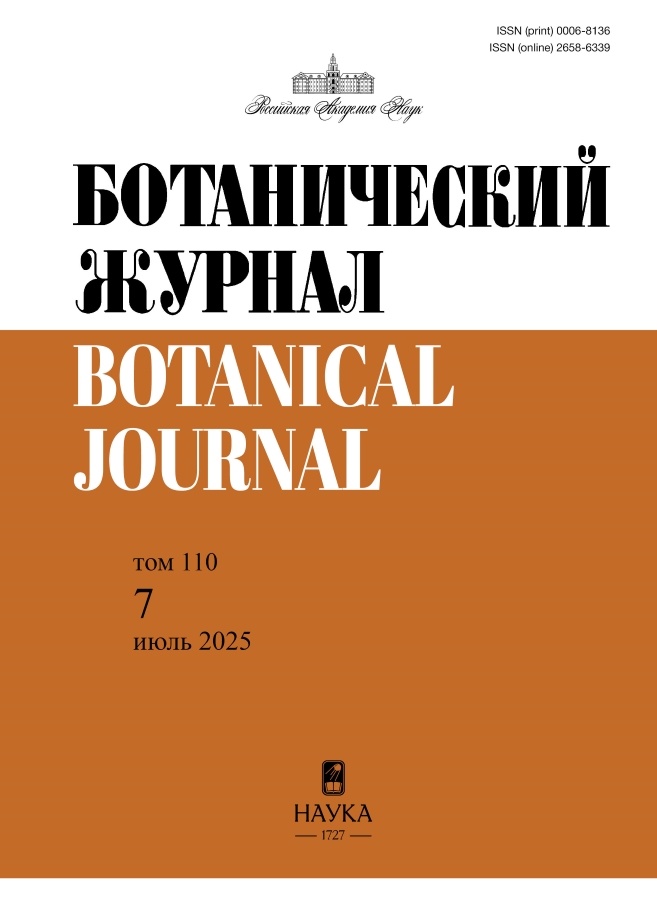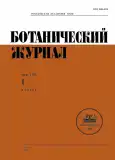ПОЛОВОЙ ПОЛИМОРФИЗМ RANUNCULUS ACRIS (RANUNCULACEAE) В МОСКОВСКОЙ ОБЛАСТИ
- Авторы: Годин В.Н.1,2
-
Учреждения:
- Московский педагогический государственный университет
- Центральный сибирский ботанический сад СО РАН
- Выпуск: Том 108, № 1 (2023)
- Страницы: 13-22
- Раздел: СООБЩЕНИЯ
- URL: https://journals.rcsi.science/0006-8136/article/view/134312
- DOI: https://doi.org/10.31857/S0006813622120031
- EDN: https://elibrary.ru/EHRWJK
- ID: 134312
Цитировать
Полный текст
Аннотация
Изучена гинодиэция у кистекорневого поликарпического растения Ranunculus acris L. в Московской области. Установлено, что R. acris образует три типа цветков, различающиеся степенью развития андроцея: обоеполые (с фертильными тычинками и плодолистиками), частично андростерильные (часть тычинок представлено стаминодиями, образующими стерильную пыльцу) и пестичные (крайняя степень редукции тычинок и полное отсутствие фертильной пыльцы). По изученным морфологическим параметрам эти цветки образуют размерный ряд от самых крупных обоеполых до наиболее мелких пестичных. Каждый тип цветка формируется на отдельных особях. В половом спектре 10 исследованных ценопопуляций доля особей с обоеполыми цветками варьирует от 43.9 до 53.0%, с частично андростерильными цветками – от 45.5 до 54.4%. Особи с пестичными цветками всегда встречаются крайне редко (1.5–2.0%). Выявлено, что за три года наблюдений (2020–2022) особи разных половых форм не меняли пол цветков, и половая структура ценопопуляций оставалась стабильной, без резких колебаний.
Ключевые слова
Об авторах
В. Н. Годин
Московский педагогический государственный университет; Центральный сибирский ботанический сад СО РАН
Автор, ответственный за переписку.
Email: vn.godin@mpgu.su
Россия, 129164, Москва, ул. Кибальчича, 6, корп. 3; Россия, 630090, Новосибирск, ул. Золотодолинская, 101
Список литературы
- Andreas C.H. 1954. Notes on Ranunculus ficaria L. in the Netherlands. I. Introduction. – Reductional trends as a possible interpretation of flower types. – Acta Bot. Neerlandica. 3 (4): 446–453. https://doi.org/10.1111/j.1438-8677.1954.tb00309.x
- Benson L. 1948. A treatise on the North American Ranunculi. – Am. Midl. Nat. 40 (1): 1–264. https://doi.org/10.2307/2421547
- Caruso C.M., Eisen K., Case A.L. 2016. An angiosperm-wide analysis of the correlates of gynodioecy. – Int. J. Plant Sci. 177(2): 115–121. https://doi.org/10.1086/684260
- Delph L.F., Galloway L.F., Stanton M.L. 1996. Sexual dimorphism in flower size. – Amer. Nat. 148 (2): 299–320. https://doi.org/10.1086/285926
- [Demyanova] Демьянова Е.И. 1981. Об особенностях распространения гинодиэции в семействе Губоцветных. – Биол. науки. 9: 69–74.
- [Demyanova] Демьянова Е.И. 2011. Спектр половых типов и форм в локальных флорах Урала (Предуралья и Зауралья). – Бот. журн. 96(10): 1297–1315.
- [Demyanova] Демьянова Е.И. 2013. О половом полиморфизме некоторых андродиэцичных растений. – Бот. журн. 98 (9): 1139–1146.
- [Demyanova] Демьянова Е.И. 2017. Антэкология и семенная продуктивность шалфея дубравного (Salvia nemorosa L.) при интродукции на Урале. – Вест. Пермского ун-та. Сер. Биология. 2: 135–144.
- [Demyanova] Демьянова Е.И. 2019. О половом полиморфизме в роде Nepeta L. –Вест. Пермского ун-та. Сер. Биология. 1: 12–20. https://doi.org/10.17072/1994-9952-2019-1-12-20
- [Efimik, Polina] Ефимик Е.Г., Полина Е.В. 2005. Особенности внутривидовой изменчивости некоторых видов рода Ranunculus L. (Ranunculaceae Juss.). – Вест. Перм. ун-та. 6: 25–27.
- [Fedorov, Artyushenko] Федоров Ал.А., Артюшен- ко З.Т. 1975. Атлас по описательной морфологии высших растений. Цветок. Л. 351 с.
- [Godin] Годин В.Н. 2009. Морфология цветков Schizonepeta multifida (Lamiaceae) в связи с половой дифференциацией. – Бот. журн. 94 (12): 1784–1790.
- [Godin] Годин В.Н. 2018. Гинодиэция Valeriana officinalis (Valerianaceae) в Московской области. – Бот. журн. 103 (10): 1265–1279. https://doi.org/10.7868/S0006813618100058
- [Godin] Годин В.Н. 2019. Распространение гинодиэции в системе APG IV. – Бот. журн. 104 (5): 345–356. https://doi.org/10.1134/S0006813619050053
- [Godin] Годин В.Н. 2020. Распространение гинодиэции у цветковых растений. – Бот. журн. 105(3): 236–252. https://doi.org/10.31857/S0006813620030023
- [Godin, Akhmetgarieva] Годин В.Н., Ахметгариева Л.Р. 2019. Гинодиэция Ajuga reptans (Lamiaceae) в Московской области. – Бот. журн. 104 (8): 1211–1227. https://doi.org/10.1134/S0006813619080027
- Harper J.L. 1957. Biological flora of the British Isles: Ranunculus acris L. (Ranunculus acer auct. plur.). – J. Ecol. 45 (1): 289–314. https://doi.org/10.2307/2257092
- Heath O.V.S., Orchard B. 1957. Variation in the number of buttercup petals. – Nature. 180 (4578): 179–180. https://doi.org/10.1038/180179b0
- [Jelenevsky, Derviz-Sokolova] Еленевский А.Г., Дервиз-Соколова Т.Г. 1981. Ревизия лютиков (Ranunculus L., Ranunculaceae) цикла Acri Ovcz. – Новости сист. высш. раст. 18: 177–190.
- Knuth P. 1898. Handbuch der Blütenbiologie. Bd. II. T. I. Leipzig. 697 S.
- Kučera J., Svitok M., Gbúrová Štubňová E., Mártonfiová L., Lafon Placette C., Slovák M. 2021. Eunuchs or females? Causes and consequences of gynodioecy on morphology, ploidy, and ecology of Stellaria gra-minea L. (Caryophyllaceae). – Front. Plant Sci. 12: 589093. https://doi.org/10.3389/fpls.2021.589093
- Kugler H. 1970. Blütenökologie. Jena. 345 S.
- Marsden-Jones E.M., Turrill W.B. 1929a. Studies in Ranunculus. – J. Genetics. 21 (2): 169–181. https://doi.org/10.1007/BF02984205
- Marsden-Jones E.M., Turrill W.B. 1929b. Variations in sex expression in Ranunculus. – Nature. 123: 798–799. https://doi.org/10.1038/123798b0
- Marsden-Jones E.M., Turrill W.B. 1935. Studies in Ranunculus. III. Further experiments concerning sex in Ranunculus acris. – J. Genetics. 31 (3): 363–378. https://doi.org/10.1007/BF02982407
- Marsden-Jones E.M., Turrill W.B. 1952. Studies in Ranunculus. IV. Additional experiments with Ranunculus bulbosus and R. acris. – J. Genetics. 51 (1): 26–31. https://doi.org/10.1007/BF02986701
- Oak M.K., Song J.H., Hong S.P. 2018. Sexual dimorphism in a gynodioecious species, Aruncus aethusifolius (Rosaceae). – Plant Syst. Evol. 304 (4): 473–484. https://doi.org/10.1007/s00606-018-1493-4
- [Ovczinnikov] Овчинников П.Н. 1937. Род Ranunculus L. – В кн.: Флора СССР. Т. 7. М., Л. С. 351–509.
- Parkin J. 1929a. Diœcism in Ranunculus acris. – Nature. 123 (3102): 568. https://doi.org/10.1038/123568b0
- Parkin J. 1929b. Reduced flowers of Ranunculus. – Nature. 123 (3111): 911. https://doi.org/10.1038/123911a0
- Pickering C.M., Ash J.E. 1993. Gender variation in hermaphrodite plants: evidence from five species of alpine Ranunculus. – Oikos. 68 (3): 539–548. https://doi.org/10.2307/3544923
- Prantl K. 1891. Ranunculaceae. – In: Die natürlichen Pflanzenfamilien. III(2). Leipzig. P. 43–66.
- [Rabotnov, Saurina] Работнов Т.А., Саурина Н.И. 1971. Численность и возрастной спектр некоторых ценотических популяций лютиков Ranunculus acris L. и R. auricomus L. – Бот. журн. 56 (4): 476–484.
- Riley L.A.M. 1923. Variable aestivation of Ranunculus bulbosus and R. acer. – J. Bot. 61: 209–212.
- Ronse de Craene L.P. 2010. Floral Diagrams. An aid to understanding flower morphology and evolution. Cambridge University Press. 441 p.
- Salisbury E.J. 1919. Variation in Eranthis hyemalis, Ficaria verna, and other members of the Ranunculaceae with special reference to trimery and the origin of the perianth. – Ann. Bot. 33 (1): 47–79. https://doi.org/10.1093/oxfordjournals.aob.a089702
- Schulz A. 1890. Beitrage zur Kenntnis der Bestaubungseinrichtungen und Geschlechtsverteilung bei den Pflanzen. – Bibliotheca Botanica. 3 (17): 1–224.
- Sokal R.R., Rohlf F.J. 2012. Biometry: the principles and practice of statistics in biological research. 4th edition. New York. 937 p.
- Sorokin H. 1927. Cytological and morphological investigations on gynodimorphic and normal forms of Ranunculus acris L. – Genetics. 12 (1): 59–83. https://doi.org/10.1093/genetics/12.1.59
- Tamura M. 1993. Ranunculaceae. – In: The families and genera of vascular plants. II. P. 563–583. Springer. https://doi.org/10.1007/978-3-662-02899-5_67
- [Tzvelev] Цвелев Н.Н. 2001. Род Лютик – Ranunculus L. – В кн.: Флора Восточной Европы. Т. 10. СПб. С. 100–158.
- Whitelegge T. 1878. Gyno-Diœcious Plants. – Nature. 18 (466): 588. https://doi.org/10.1038/018588a0
Дополнительные файлы










